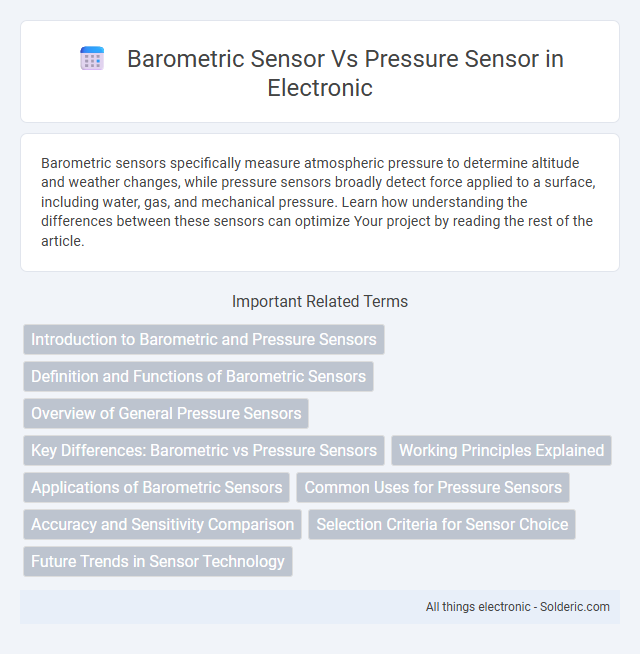Barometric sensors specifically measure atmospheric pressure to determine altitude and weather changes, while pressure sensors broadly detect force applied to a surface, including water, gas, and mechanical pressure. Learn how understanding the differences between these sensors can optimize Your project by reading the rest of the article.
Comparison Table
| Feature | Barometric Sensor | Pressure Sensor |
|---|---|---|
| Purpose | Measures atmospheric pressure | Measures pressure of gases or liquids |
| Measurement Range | Typically 300 to 1100 hPa | Varies widely; from vacuum to thousands of PSI |
| Applications | Weather forecasting, altimeters, meteorology | Industrial processes, automotive, HVAC, medical devices |
| Output | Analog/digital atmospheric pressure readings | Analog/digital pressure readings (fluid or gas) |
| Sensitivity | High sensitivity to atmospheric pressure changes | Depends on sensor type; can measure high and low pressures |
| Examples | MEMS barometric pressure sensors (BMP280, BME280) | Strain gauge sensors, piezoelectric sensors |
Introduction to Barometric and Pressure Sensors
Barometric sensors measure atmospheric pressure to determine altitude and weather changes, while pressure sensors detect force applied by liquids or gases in various applications such as industrial systems and automotive engines. Barometric sensors typically provide data for environmental monitoring and navigation, whereas pressure sensors ensure operational safety and efficiency by monitoring fluid or gas pressures. Both sensors utilize strain gauges, piezoelectric elements, or capacitive components to convert pressure changes into electrical signals for precise measurement.
Definition and Functions of Barometric Sensors
Barometric sensors, a specialized type of pressure sensor, measure atmospheric pressure to determine altitude or weather changes by detecting air pressure variations. These sensors convert pressure data into electrical signals for precise applications in smartphones, GPS systems, and weather stations. Their function differs from general pressure sensors, which measure pressure in gases or liquids for industrial, automotive, or medical purposes without necessarily tracking atmospheric conditions.
Overview of General Pressure Sensors
General pressure sensors measure the force exerted by gases or liquids on a surface, providing essential data for various industrial and consumer applications. Barometric sensors, a specialized type of pressure sensor, specifically detect atmospheric pressure to aid in weather forecasting, altitude determination, and environmental monitoring. Your choice depends on whether you need broad pressure measurements or precise atmospheric pressure readings.
Key Differences: Barometric vs Pressure Sensors
Barometric sensors specifically measure atmospheric pressure to determine altitude and weather changes, whereas pressure sensors measure the force exerted by liquids or gases in various industrial and medical applications. Barometric sensors are calibrated for environmental conditions and provide precise measurements for altitude estimation, while general pressure sensors cover a broader range of pressures, including hydraulic and pneumatic systems. Your choice depends on whether you need detailed atmospheric data or versatile pressure monitoring across different mediums.
Working Principles Explained
Barometric sensors measure atmospheric pressure by detecting changes in air pressure using a strain gauge or piezoelectric sensor, which converts pressure fluctuations into electrical signals. Pressure sensors operate by measuring the force exerted by a gas or liquid on a surface, often using capacitive, piezoelectric, or piezoresistive elements that deform under pressure to generate a measurable output. Both sensors rely on transducing physical pressure variations into electrical signals, but barometric sensors are specifically calibrated for ambient atmospheric conditions, whereas general pressure sensors can measure a wide range of pressures in various environments.
Applications of Barometric Sensors
Barometric sensors, a type of pressure sensor, are widely used in weather forecasting, altimeters for aircraft, and mobile devices for elevation tracking. These sensors measure atmospheric pressure changes with high accuracy, enabling precise altitude determination and weather pattern analysis. Their integration into smartphones and wearable technology enhances navigation and fitness tracking through real-time environmental data.
Common Uses for Pressure Sensors
Pressure sensors are widely used in various industries to monitor and control fluid and gas pressures in applications such as HVAC systems, automotive braking systems, and industrial automation. Barometric sensors, a specific type of pressure sensor, measure atmospheric pressure and are essential for weather forecasting, altitude detection, and GPS calibration. Your choice depends on whether you need to measure ambient atmospheric pressure or the pressure within a closed system.
Accuracy and Sensitivity Comparison
Barometric sensors typically offer higher accuracy in measuring atmospheric pressure with a precision range of +-0.1 hPa, making them ideal for applications like weather monitoring and altimetry. Pressure sensors, especially those designed for industrial use, provide a broader measurement range but often with less sensitivity, around +-1 to +-5 hPa, suitable for detecting pressure variations in liquids and gases. The sensitivity of barometric sensors allows for detecting minute pressure changes, while standard pressure sensors prioritize robustness and range over fine accuracy.
Selection Criteria for Sensor Choice
Selecting between a barometric sensor and a pressure sensor depends on the specific application requirements such as accuracy, range, and environmental conditions. Barometric sensors excel in measuring atmospheric pressure for altitude and weather monitoring, while pressure sensors are suited for broader uses including industrial fluid and gas pressure measurement. Your choice should prioritize sensor sensitivity, response time, and compatibility with the operating environment to ensure optimal performance and reliability.
Future Trends in Sensor Technology
Future trends in sensor technology emphasize the integration of barometric and pressure sensors with AI-driven data analytics to enhance environmental monitoring and aerospace applications. Advances in microelectromechanical systems (MEMS) enable miniaturization, increased sensitivity, and lower power consumption, facilitating widespread adoption in wearable devices and smart infrastructure. Innovations in nanomaterials and IoT connectivity will drive the development of multi-functional sensors capable of real-time pressure and altitude measurement with improved accuracy and durability.
Barometric sensor vs pressure sensor Infographic

 solderic.com
solderic.com